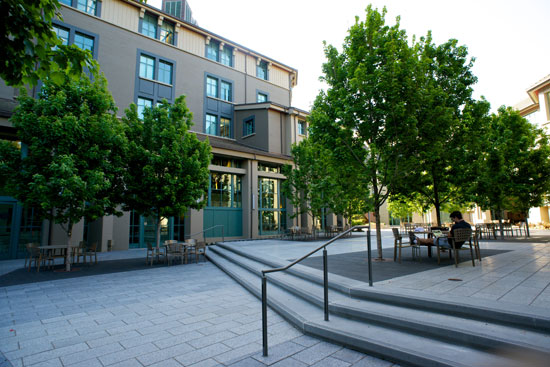Trees Need Dirt
The Ways in which Urban Forests Enhance a Project
The benefits of urban forests to the entire project can be measured not just environmentally, but also economically, and socially. (3- Sustainable Cities Institute)
Environmental Benefits of Urban Tree Planting
The environmental benefits of trees are generally well known and are those benefits that are most directly addressed by sustainable design criteria. These benefits include the following:
- Trees assist with the improvement of air quality by mitigating air pollution and greenhouse gases. Trees use photosynthesis to convert carbon dioxide (CO2) into nutrients and this process helps to reduce the amount of CO2, which is a greenhouse gas. Reduction in greenhouse gases reduces smog and unhealthy air quality in urban environments. Trees also capture particulate matter on their leaves and trunks, preventing it from being breathed in by people.
- Trees help to reduce stormwater runoff and improve water quality. Large amounts of impervious surfaces force excess storm water to accumulate on pavement surfaces faster than the sewer system can absorb. Trees are able to capture large amounts of rain through their canopies and root systems. In addition to absorbing storm water through their roots and canopies, trees also help to filter some of the pollutants carried with the storm water.
- Trees help to reduce the urban heat island effect. Large areas of pavement trap the heat of the sun and reflect it back into the environment, thus raising the temperature in surrounding areas. This process contributes to smog, global warming and higher energy costs associated with increased air conditioning in nearby buildings. Many community zoning codes now require the strategic placement of trees in and around parking lots and around buildings to provide shading and thus, limit the heat island effect.
- Urban trees and forests help to reduce, and even eliminate, erosion. Strong winds and storm water runoff can erode arable soil. The roots of trees bind to the soil and can prevent soil loss.
- Trees shelter wildlife and promote biodiversity. Trees provide a necessary habitat for a wide variety of urban wildlife. A single oak tree can support up to 500 species of insects and invertebrate species.
- Healthy urban forests contribute to the stabilization of watersheds. Trees absorb large quantities of water through their root systems, and their canopies intercept additional rain before it even hits the ground, and thus help to mitigate flooding. Soil absorbs and retains rainwater, which is then released slowly into the groundwater. Tree roots create air pockets within soil and the air pockets filter contaminants which would otherwise enter groundwater sources such as aquifers, streams, and lakes.
Economic Benefits of Urban Forests
The economic benefits of urban forests are less obvious than the environmental ones but these benefits have an impact on the short and long-term effects of a project. With enhanced property values and aesthetic qualities, building projects become easier to sell or lease as well as more economical to operate.
- Trees increase property values. The USDA Forest Service has found that mature trees add an average of 10 percent to a property's value. This fact is also realized by the US Association of Realtors.
- Businesses do better on tree lined streets. A 2004 study found that consumers overwhelmingly preferred business areas with well-planted canopy-covered streets and suggests a link to the amount of time that shoppers are willing to spend in stores.
- Trees can reduce heating and cooling costs for buildings. Trees can reduce cooling costs by 30 percent, and heating costs by 20-50 percent. Trees cool buildings during hot weather by providing shade, and limit snow accumulations during cold weather by providing a barrier to wind. This presents an economic benefit to a building project as it can reduce the fuel costs associated with heating and cooling.
- Crime rates tend to be lower in areas with trees. Research presented at the American Association for the Advancement of Science conference (AAAS) in Chicago showed that the presence of trees could cut crime by as much as 7 percent.
 |
Healthy urban forests can enhance the environmental, economic and social conditions in urban areas. Photo courtesy of DeepRoot Green Infrastructure |
Social Benefits of Trees
Social benefits are difficult to quantify, but they contribute to the quality of life and the overall well-being in a community.
- Trees provide aesthetic benefits by creating more desirable landscapes and helping to define community character. Through size and color they soften the harsh urban landscape. Species type, placement, and even long-standing individual trees help to define regional history, culture, and community character.
- Trees and urban forests encourage community interaction. People tend to gather more when green spaces are available.
- Trees reduce noise pollution by blocking urban noise. Noise reduction has been shown to reduce stress for people living and working around trees.
- Urban forests provide opportunities for environmental educational programs for both children and adults. Many schools have “outdoor classrooms” with curricula designed for the natural sciences.









